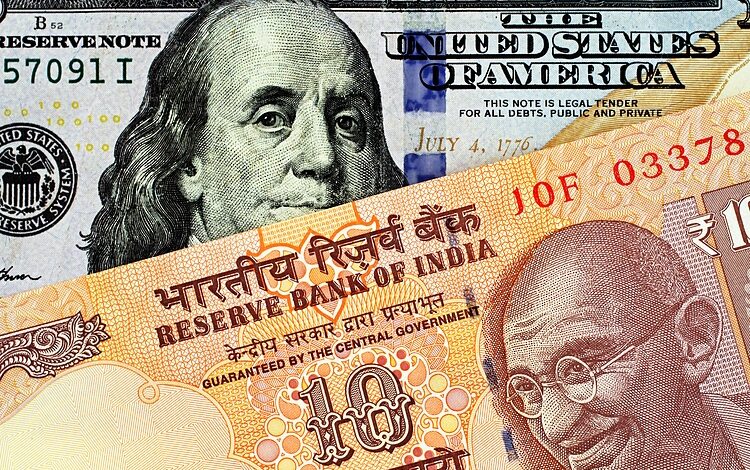USD/INR loses momentum amid thin US holiday trading

- Indian Rupee attracts some buyers on the softer USD.
- The IMF projected the Indian economy to remain strong at 6.5% in both 2024 and 2025.
- The FOMC Minutes from the January meeting will be due on Wednesday.
Indian Rupee (INR) gathers strength on Monday amid the decline of the US Dollar (USD). The positive economic outlook of India provides some support to the INR. The International Monetary Fund (IMF) said in its latest World Economic Outlook update that economic growth in India was projected to remain strong at 6.5% in both 2024 and 2025.
While Japan has unexpectedly slipped into a recession, India still shines as a ‘bright spot’ on the global map. The IMF forecasts that India will surpass both Japan and Germany in terms of economic output in 2026 and 2027, respectively. However, the geopolitical tension in the Middle East and economic headwinds might cap the upside of INR and drag the pair lower.
US markets are closed on Monday due to the President’s Day holiday. Market participants will keep an eye on the FOMC Minutes from the January meeting, due on Wednesday. The attention will turn to India’s S&P Global Services PMI and RBI MPC Meeting Minutes on Thursday.
Daily Digest Market Movers: Indian Rupee remains strong despite geopolitical tensions and economic headwinds
- India’s goods trade deficit narrowed by nearly 12% in January compared to the previous month. The trade deficit dropped to $17.49 billion in January from $19.80 billion in December.
- Imports fell to $54.41 billion, from $58.25 billion in December. Exports decreased modestly in January to $36.92 billion from $38.45 billion in December. The slump in exports is mostly due to the geopolitical conflict in the Red Sea.
- The US Producer Price Index (PPI) for January increased by 0.3% MoM from a 0.1% decline in December. The PPI figure rose 0.9% in a year, beating market expectations.
- US Housing Starts fell -14.8% from 1.562M to 1.331M, while Building Permits slumped -1.5% from 1.8% in the previous reading.
- The Michigan Consumer Sentiment Index improved to 79.6 in February from January’s reading of 79.0, below the market consensus.
Technical Analysis: Indian Rupee witnesses an upswing within the longer band
Indian Rupee trades firmer on the day. USD/INR has traded within a multi-month-old descending trend channel of 82.70–83.20 since December 8, 2023.
In the near term, USD/INR maintains a bearish bias as the pair is below the key 100-period Exponential Moving Average (EMA) on the daily chart. Furthermore, the 14-day Relative Strength Index (RSI) holds below the 50.0 midline, suggesting the path of least resistance level is to the downside.
The immediate resistance level for the pair is located near a high of February 14 at 83.10. The crucial upside barrier will emerge near the upper boundary of the descending trend channel at 83.20. Any follow-through buying above 83.20 will pave the way to a high of January 2 at 83.35, followed by the 84.00 psychological level.
On the downside, the initial support level for USD/INR is seen near a low of February 2 at 82.83. The additional downside filter to watch is the lower limit of the descending trend channel at 82.70, en route to a low of August 23 at 82.45.
US Dollar price today
The table below shows the percentage change of US Dollar (USD) against listed major currencies today. US Dollar was the weakest against the Japanese Yen.
| USD | EUR | GBP | CAD | AUD | JPY | NZD | CHF | |
| USD | 0.03% | -0.06% | 0.01% | -0.02% | -0.12% | -0.02% | 0.02% | |
| EUR | -0.03% | -0.09% | -0.02% | -0.05% | -0.14% | -0.05% | 0.00% | |
| GBP | 0.06% | 0.09% | 0.07% | 0.04% | -0.06% | 0.04% | 0.08% | |
| CAD | -0.01% | 0.02% | -0.07% | -0.03% | -0.12% | -0.03% | 0.01% | |
| AUD | 0.02% | 0.03% | -0.05% | 0.02% | -0.10% | 0.00% | 0.04% | |
| JPY | 0.12% | 0.14% | 0.08% | 0.12% | 0.09% | 0.10% | 0.14% | |
| NZD | 0.02% | 0.05% | -0.04% | 0.03% | 0.00% | -0.10% | 0.04% | |
| CHF | -0.02% | 0.01% | -0.08% | -0.01% | -0.04% | -0.14% | -0.04% |
The heat map shows percentage changes of major currencies against each other. The base currency is picked from the left column, while the quote currency is picked from the top row. For example, if you pick the Euro from the left column and move along the horizontal line to the Japanese Yen, the percentage change displayed in the box will represent EUR (base)/JPY (quote).
Indian Rupee FAQs
What are the key factors driving the Indian Rupee?
The Indian Rupee (INR) is one of the most sensitive currencies to external factors. The price of Crude Oil (the country is highly dependent on imported Oil), the value of the US Dollar – most trade is conducted in USD – and the level of foreign investment, are all influential. Direct intervention by the Reserve Bank of India (RBI) in FX markets to keep the exchange rate stable, as well as the level of interest rates set by the RBI, are further major influencing factors on the Rupee.
How do the decisions of the Reserve Bank of India impact the Indian Rupee?
The Reserve Bank of India (RBI) actively intervenes in forex markets to maintain a stable exchange rate, to help facilitate trade. In addition, the RBI tries to maintain the inflation rate at its 4% target by adjusting interest rates. Higher interest rates usually strengthen the Rupee. This is due to the role of the ‘carry trade’ in which investors borrow in countries with lower interest rates so as to place their money in countries’ offering relatively higher interest rates and profit from the difference.
What macroeconomic factors influence the value of the Indian Rupee?
Macroeconomic factors that influence the value of the Rupee include inflation, interest rates, the economic growth rate (GDP), the balance of trade, and inflows from foreign investment. A higher growth rate can lead to more overseas investment, pushing up demand for the Rupee. A less negative balance of trade will eventually lead to a stronger Rupee. Higher interest rates, especially real rates (interest rates less inflation) are also positive for the Rupee. A risk-on environment can lead to greater inflows of Foreign Direct and Indirect Investment (FDI and FII), which also benefit the Rupee.
How does inflation impact the Indian Rupee?
Higher inflation, particularly, if it is comparatively higher than India’s peers, is generally negative for the currency as it reflects devaluation through oversupply. Inflation also increases the cost of exports, leading to more Rupees being sold to purchase foreign imports, which is Rupee-negative. At the same time, higher inflation usually leads to the Reserve Bank of India (RBI) raising interest rates and this can be positive for the Rupee, due to increased demand from international investors. The opposite effect is true of lower inflation.
Information on these pages contains forward-looking statements that involve risks and uncertainties. Markets and instruments profiled on this page are for informational purposes only and should not in any way come across as a recommendation to buy or sell in these assets. You should do your own thorough research before making any investment decisions. FXStreet does not in any way guarantee that this information is free from mistakes, errors, or material misstatements. It also does not guarantee that this information is of a timely nature. Investing in Open Markets involves a great deal of risk, including the loss of all or a portion of your investment, as well as emotional distress. All risks, losses and costs associated with investing, including total loss of principal, are your responsibility. The views and opinions expressed in this article are those of the authors and do not necessarily reflect the official policy or position of FXStreet nor its advertisers. The author will not be held responsible for information that is found at the end of links posted on this page.
If not otherwise explicitly mentioned in the body of the article, at the time of writing, the author has no position in any stock mentioned in this article and no business relationship with any company mentioned. The author has not received compensation for writing this article, other than from FXStreet.
FXStreet and the author do not provide personalized recommendations. The author makes no representations as to the accuracy, completeness, or suitability of this information. FXStreet and the author will not be liable for any errors, omissions or any losses, injuries or damages arising from this information and its display or use. Errors and omissions excepted.
The author and FXStreet are not registered investment advisors and nothing in this article is intended to be investment advice.



